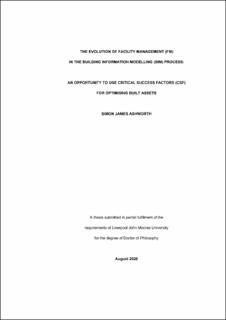Please use this identifier to cite or link to this item:
https://doi.org/10.21256/zhaw-23940Full metadata record
| DC Field | Value | Language |
|---|---|---|
| dc.contributor.advisor | Tucker, Matthew | - |
| dc.contributor.author | Ashworth, Simon | - |
| dc.date.accessioned | 2022-01-20T09:52:58Z | - |
| dc.date.available | 2022-01-20T09:52:58Z | - |
| dc.date.issued | 2021-01-12 | - |
| dc.identifier.uri | https://digitalcollection.zhaw.ch/handle/11475/23940 | - |
| dc.description | The work is available online at LJMU and also via ResearchGate (https://www.researchgate.net/profile/Simon-Ashworth-4) | de_CH |
| dc.description.abstract | Purpose: To explore the evolution of Facility Management (FM) in the Building Information Modelling (BIM) process. The research aimed to establish Critical Success Factors (CSF) which help deliver successful BIM projects, and to present these in a ‘FM-BIM Mobilisation Framework’. Background: Inefficiencies, poor collaboration and a focus on short-term costs in the construction industry, combined with a lack of innovation and digital competency when ordering projects, have resulted in a failure to deliver assets which have sustainable outcomes over their whole-life. Methodology: A mixed methods concurrent convergent design, incorporating side-by-side narrative text analysis was adopted to merge qualitative/quantitative findings. Critical Success Themes (CST) from literature were then used to establish CSF through; 19 interviews with FM/BIM experts, and a questionnaire to gauge FM industry awareness of BIM (using UK and international inputs). The final merged CSF were incorporated into a framework. This was validated using a two-stage process with a focus group using some of the same FM/BIM experts. Key findings: 10 CSF Main-Themes (MT), with a 100 Sub-Themes (ST) were identified covering important digital skills, knowledge and competences people require to contribute to the BIM process. Clients and Facility Mangers (FMs) must engage early if the full benefits of BIM are to be realised in the operational phase. They must clearly define their information requirements to align with business processes, and collaborate with the delivery team to ensure information is captured/transferred into the relevant management systems. Originality/value: The comprehensive end-to-end framework combines FM and BIM CSF into one online interactive tool which provides a wealth of useful knowledge, sources, benefits and practical examples. Although based on the UK BIM Framework, the alignment with ‘ISO 19650’ ensures it will also benefit an international audience. | de_CH |
| dc.format.extent | 523 | de_CH |
| dc.language.iso | en | de_CH |
| dc.publisher | Liverpool John Moores University | de_CH |
| dc.rights | https://creativecommons.org/licenses/by-nc/4.0/ | de_CH |
| dc.subject | BIM | de_CH |
| dc.subject | Facility Management | de_CH |
| dc.subject | Building Information Modelling | de_CH |
| dc.subject | Digitalisation | de_CH |
| dc.subject | Information requirement | de_CH |
| dc.subject | ISO 19659 | de_CH |
| dc.subject.ddc | 658.2: Facility Management | de_CH |
| dc.subject.ddc | 690: Hausbau und Bauhandwerk | de_CH |
| dc.title | The evolution of Facility Management (FM) in the Building Information Modelling (BIM) process : an opportunity to use Critical Success Factors (CSF) for optimising built assets | de_CH |
| dc.type | Dissertation | de_CH |
| dcterms.type | Text | de_CH |
| zhaw.departement | Life Sciences und Facility Management | de_CH |
| zhaw.organisationalunit | Institut für Facility Management (IFM) | de_CH |
| zhaw.publisher.place | Liverpool | de_CH |
| dc.identifier.doi | 10.24377/LJMU.t.00014250 | de_CH |
| dc.identifier.doi | 10.21256/zhaw-23940 | - |
| zhaw.originated.zhaw | Yes | de_CH |
| zhaw.display.portrait | Yes | de_CH |
| Appears in collections: | Publikationen Life Sciences und Facility Management | |
Files in This Item:
| File | Description | Size | Format | |
|---|---|---|---|---|
| 2021_Ashworth-Evolution-of-FM-in-BIM-process_PHD.pdf | 24.34 MB | Adobe PDF |  View/Open |
Show simple item record
Ashworth, S. (2021). The evolution of Facility Management (FM) in the Building Information Modelling (BIM) process : an opportunity to use Critical Success Factors (CSF) for optimising built assets [Doctoral dissertation, Liverpool John Moores University]. https://doi.org/10.24377/LJMU.t.00014250
Ashworth, S. (2021) The evolution of Facility Management (FM) in the Building Information Modelling (BIM) process : an opportunity to use Critical Success Factors (CSF) for optimising built assets. Doctoral dissertation. Liverpool John Moores University. Available at: https://doi.org/10.24377/LJMU.t.00014250.
S. Ashworth, “The evolution of Facility Management (FM) in the Building Information Modelling (BIM) process : an opportunity to use Critical Success Factors (CSF) for optimising built assets,” Doctoral dissertation, Liverpool John Moores University, Liverpool, 2021. doi: 10.24377/LJMU.t.00014250.
ASHWORTH, Simon, 2021. The evolution of Facility Management (FM) in the Building Information Modelling (BIM) process : an opportunity to use Critical Success Factors (CSF) for optimising built assets. Doctoral dissertation. Liverpool: Liverpool John Moores University
Ashworth, Simon. 2021. “The Evolution of Facility Management (FM) in the Building Information Modelling (BIM) Process : An Opportunity to Use Critical Success Factors (CSF) for Optimising Built Assets.” Doctoral dissertation, Liverpool: Liverpool John Moores University. https://doi.org/10.24377/LJMU.t.00014250.
Ashworth, Simon. The Evolution of Facility Management (FM) in the Building Information Modelling (BIM) Process : An Opportunity to Use Critical Success Factors (CSF) for Optimising Built Assets. Liverpool John Moores University, 12 Jan. 2021, https://doi.org/10.24377/LJMU.t.00014250.
Items in DSpace are protected by copyright, with all rights reserved, unless otherwise indicated.